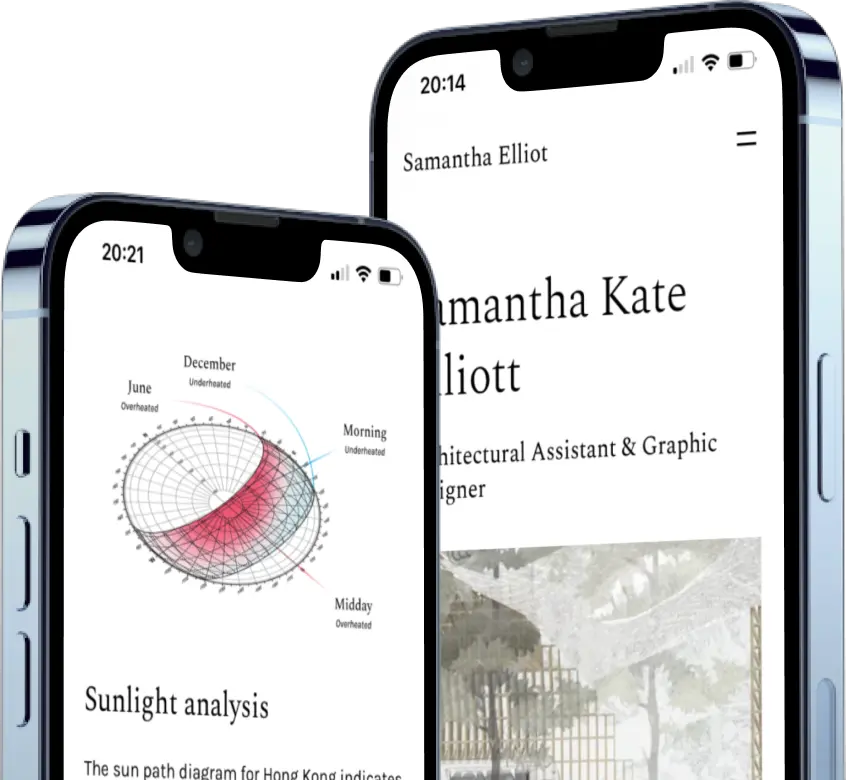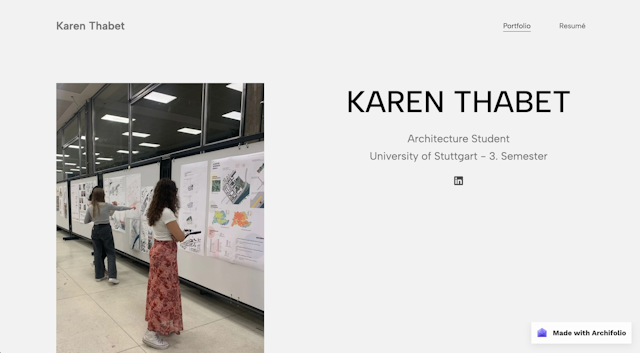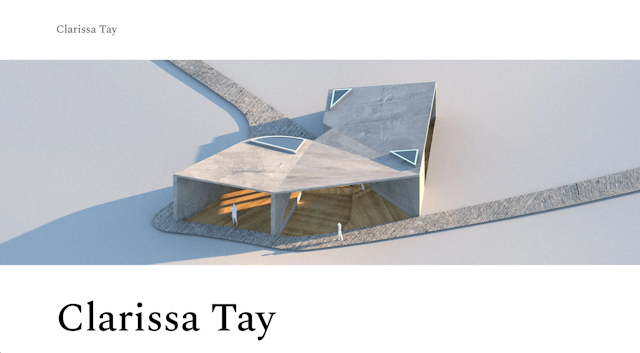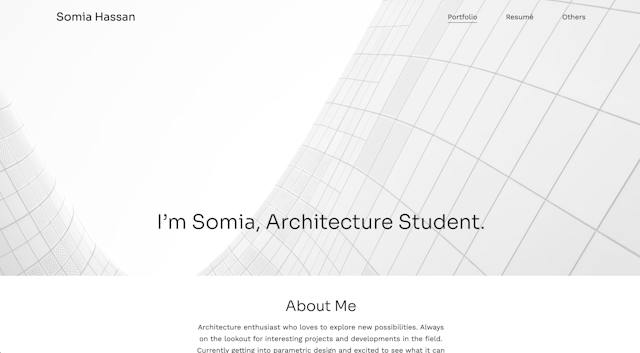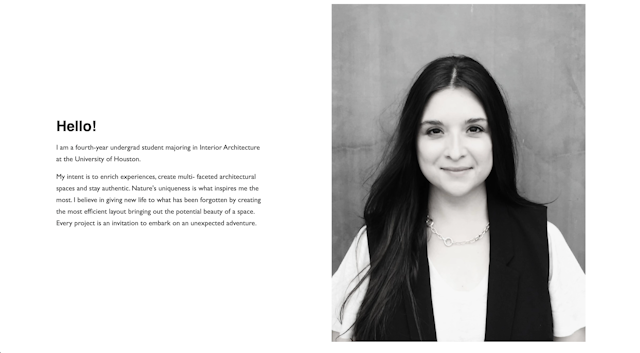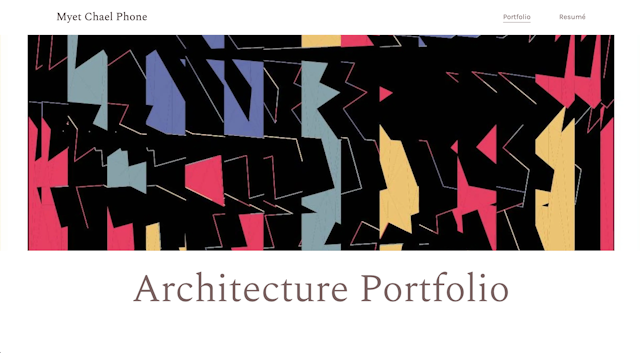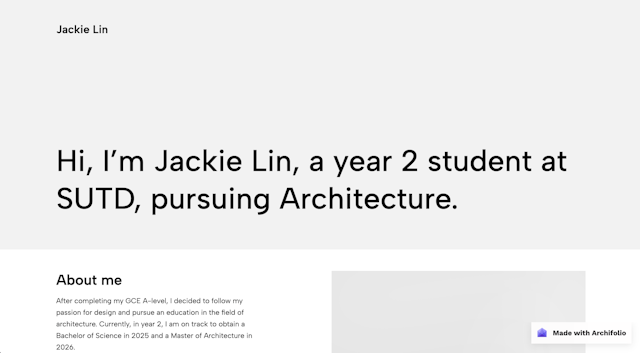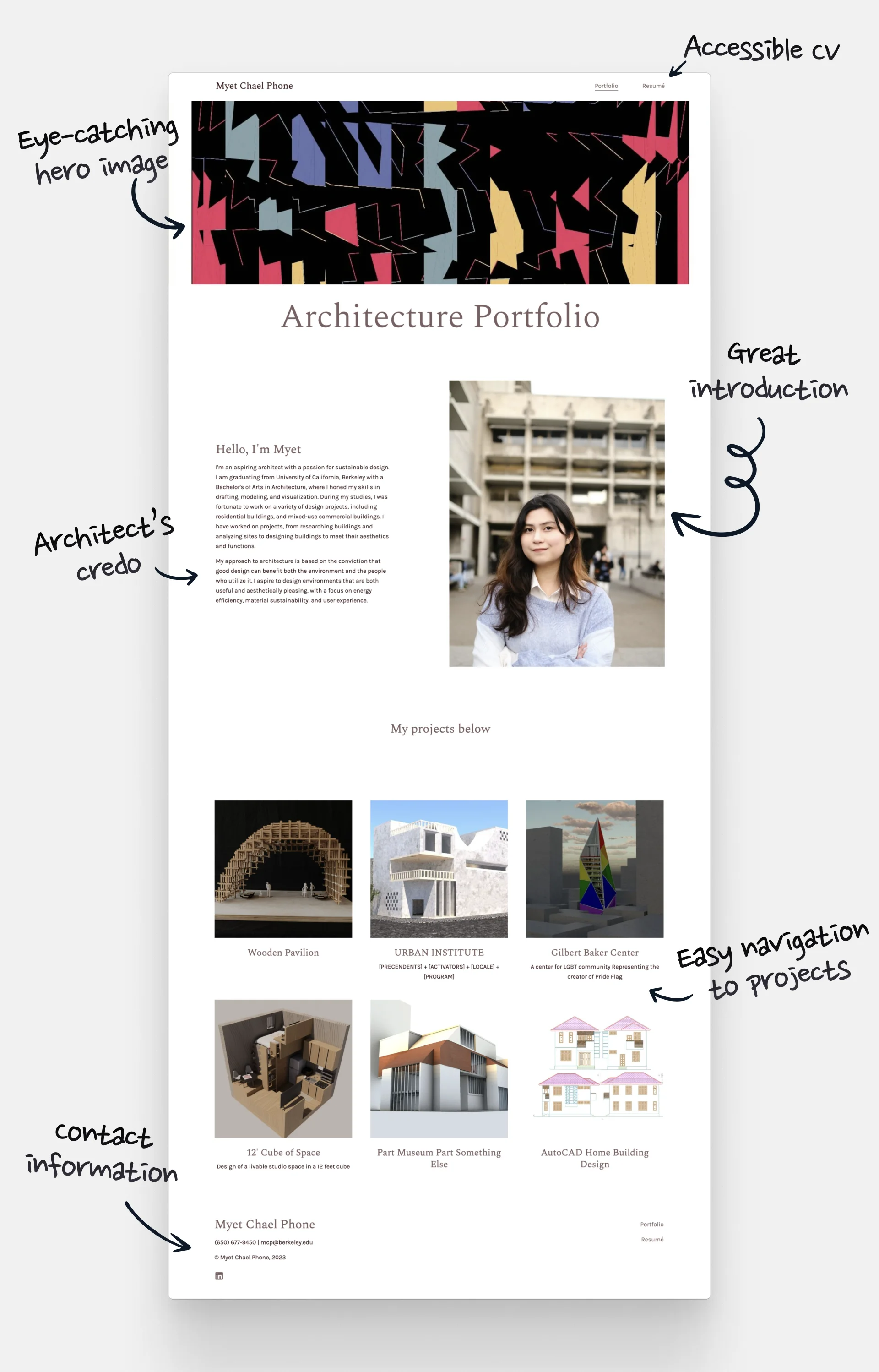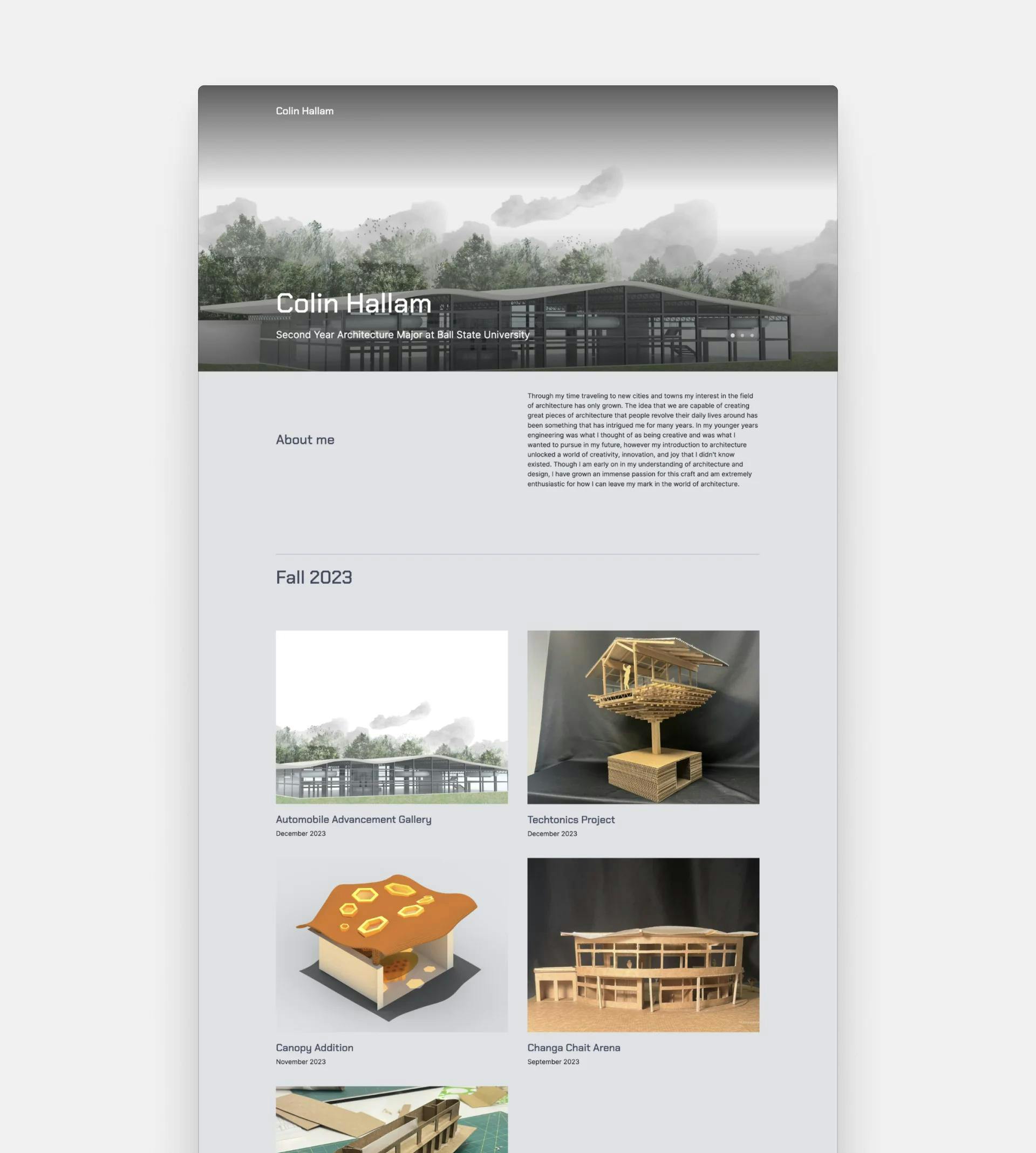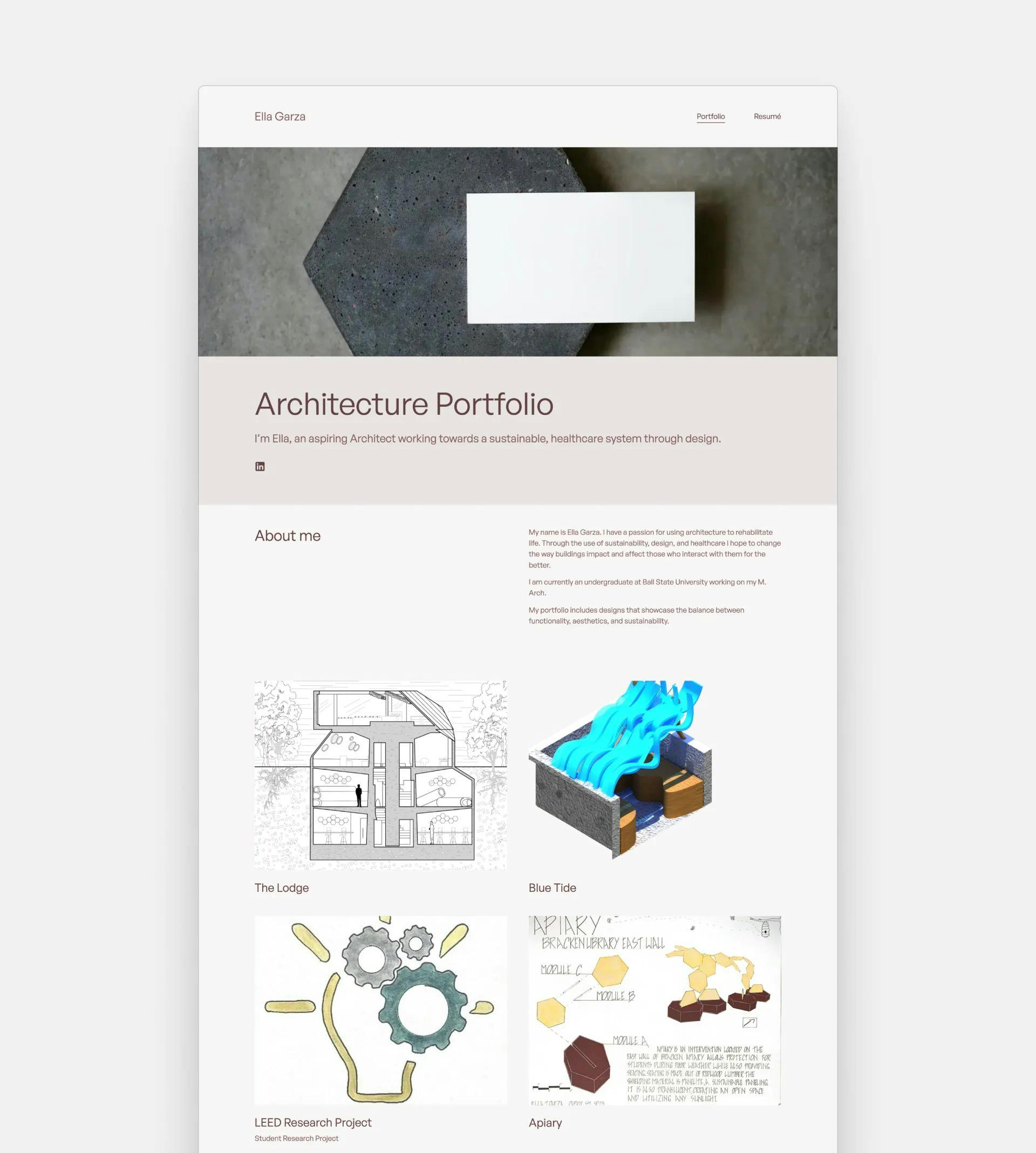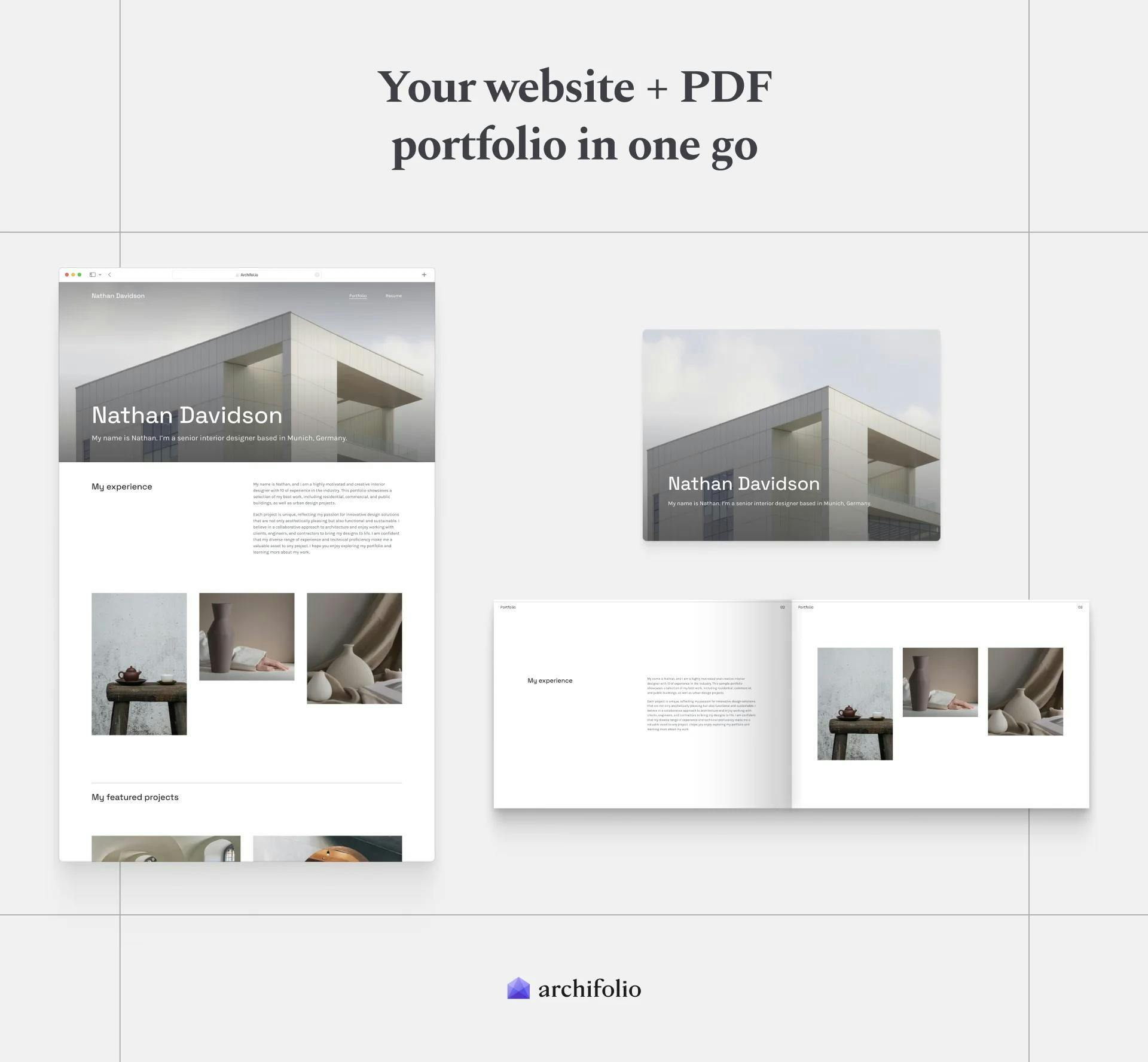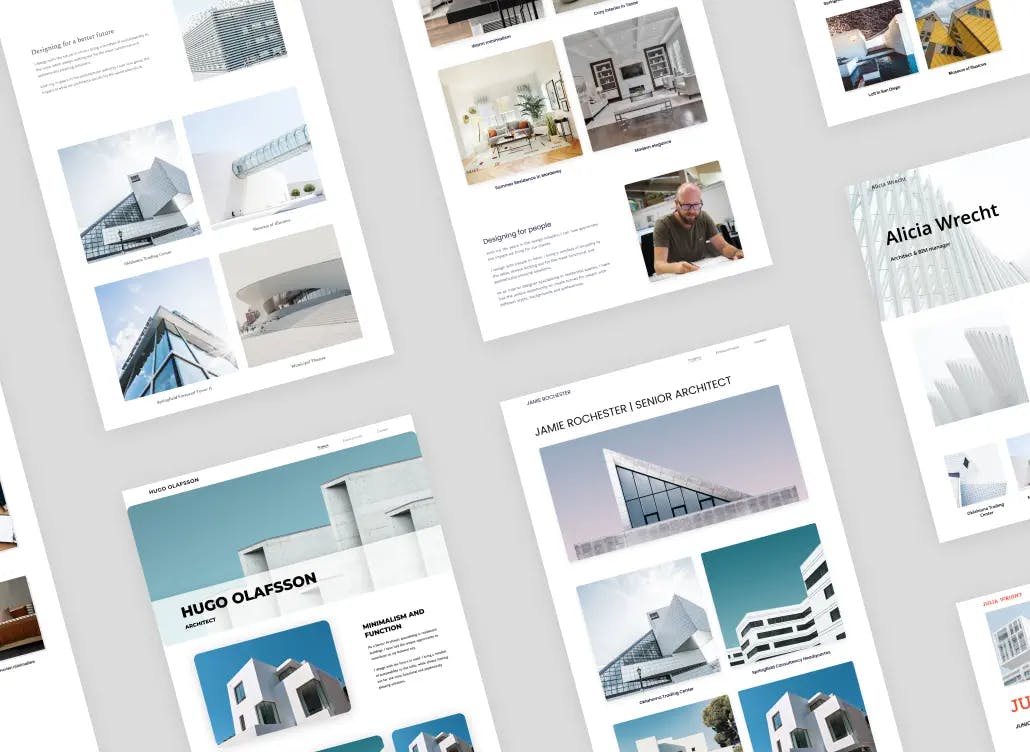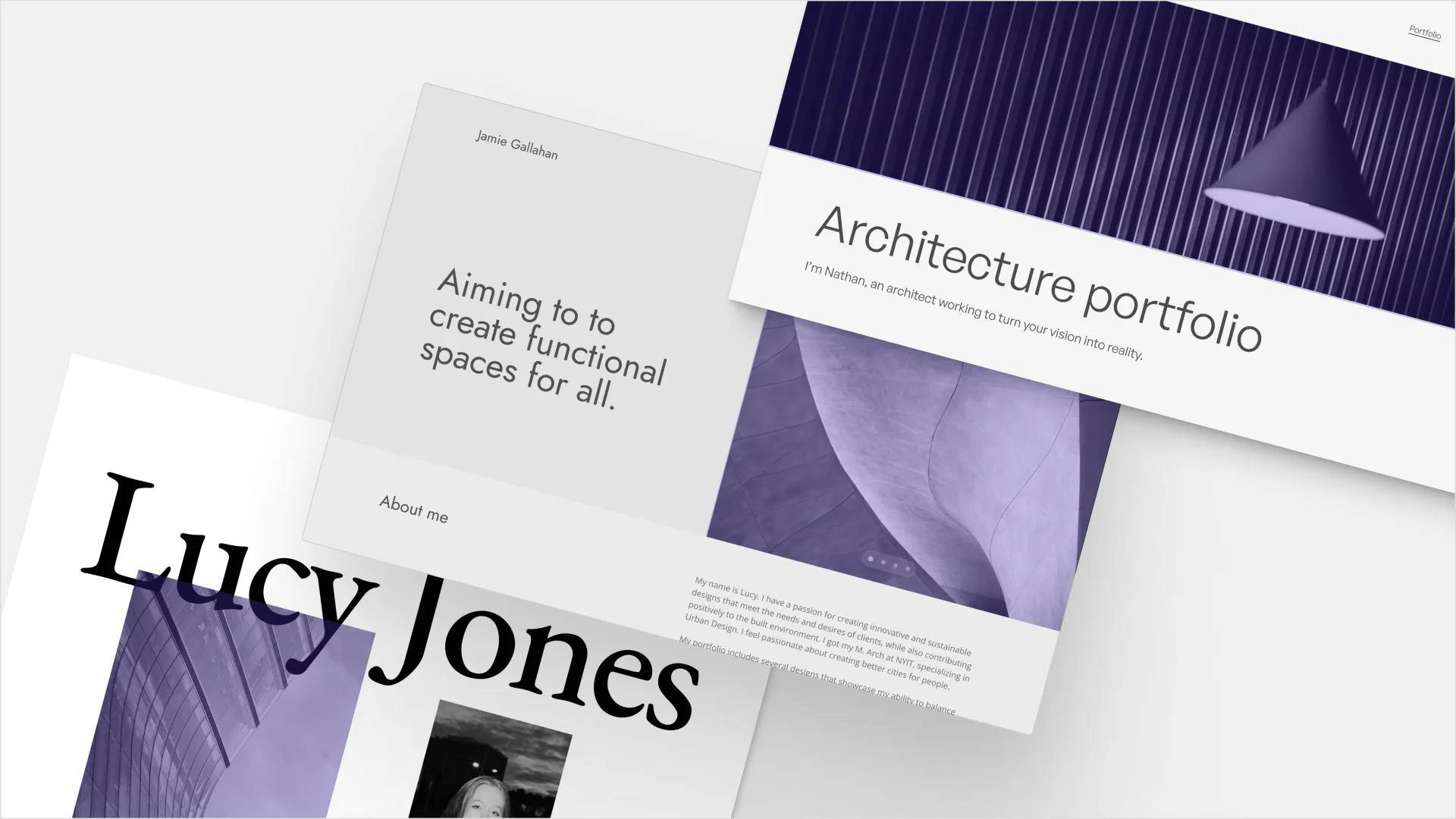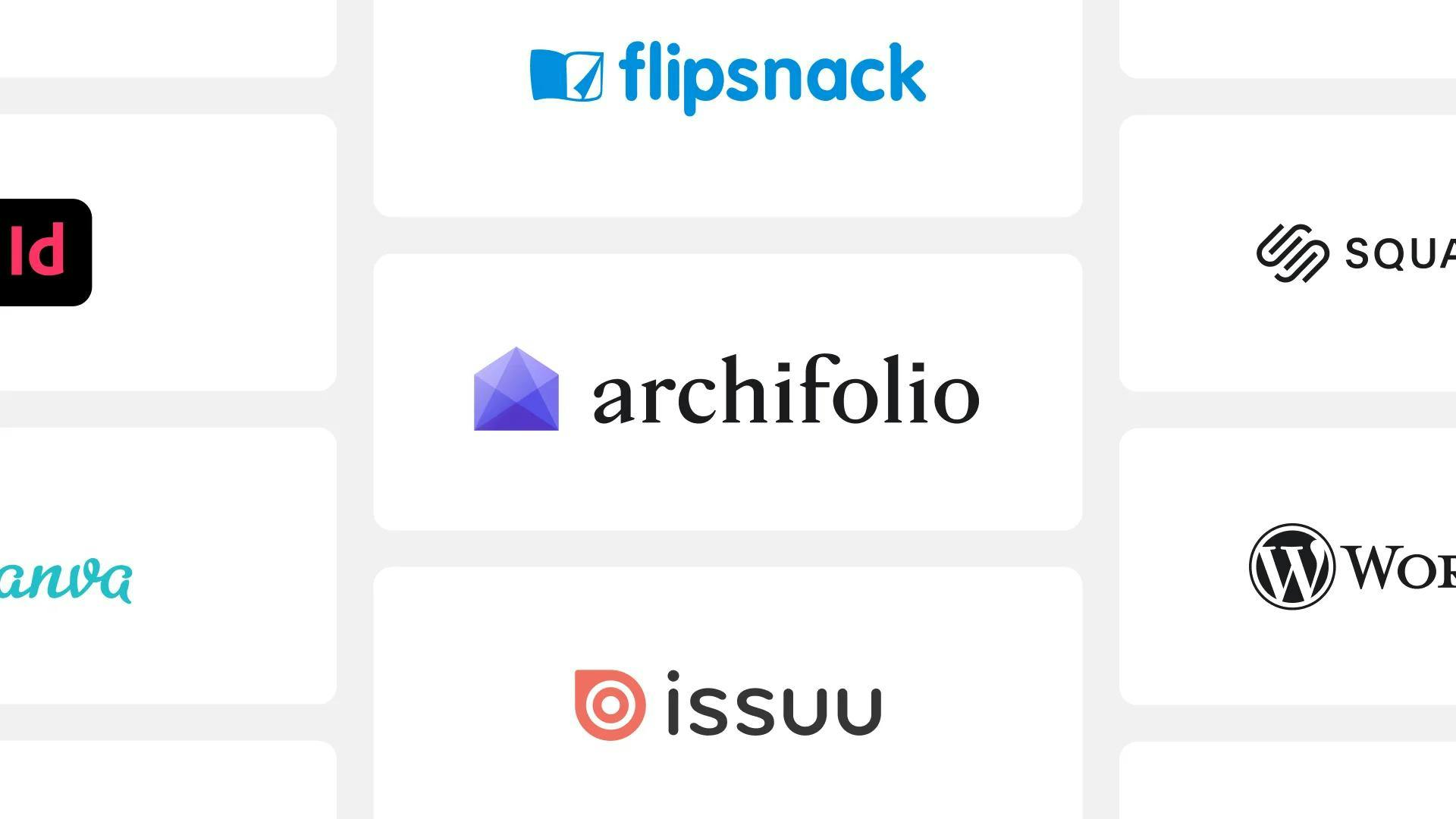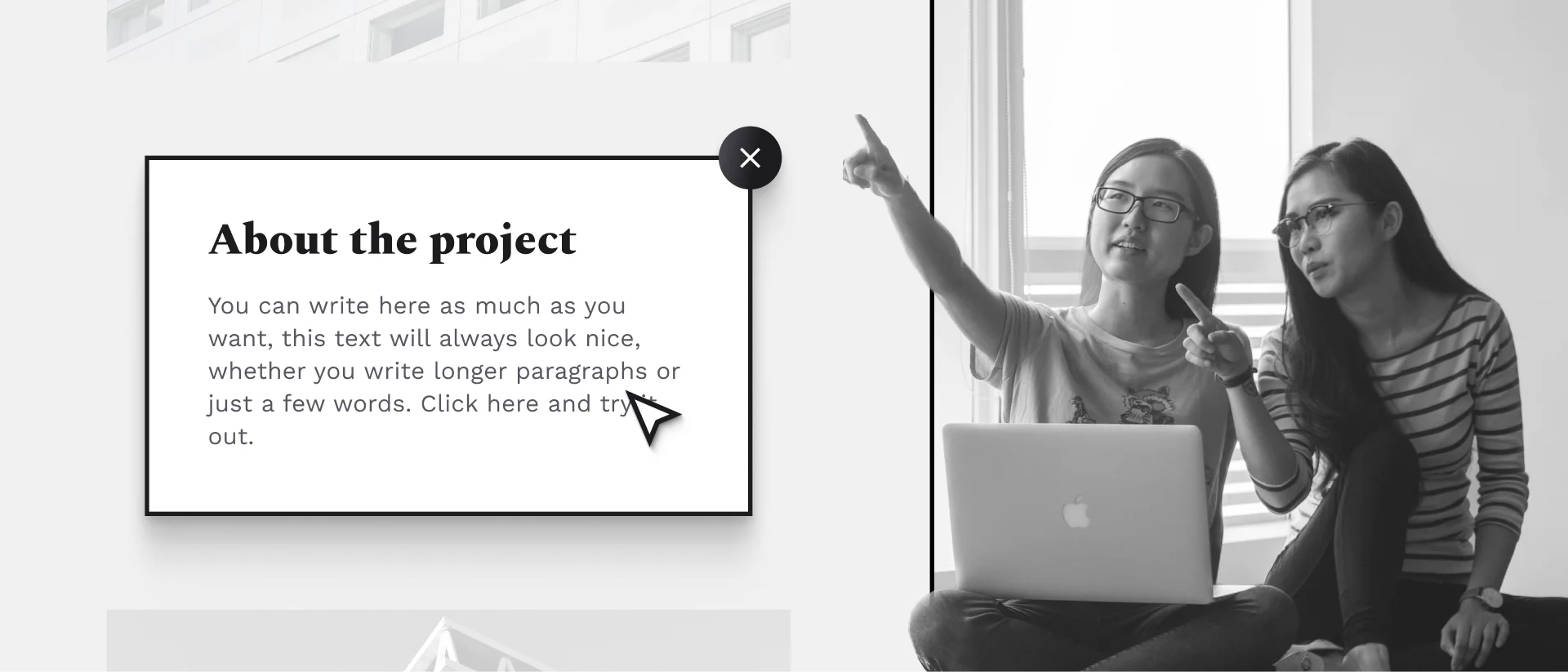
8 Tips for a Stunning Undergraduate Architecture Portfolio + Examples
There’s fierce competition to get accepted to any studies related to architecture all around the world. You need an exceptional undergraduate architecture portfolio to stand out from the crowd.
The team of Archifolio is here to make this process less stressful– and even fun.
In this article, we’ll talk about creating undergraduate architecture portfolios for when you are applying for your first degree, and also when you’d like to get accepted to your Masters’ studies. But let's start with some examples, shall we?
Undergraduate Architecture Portfolio Examples
Archifolio's top picks:
Myet Chael Phone's portfolio
Myet created a stunning architecture portfolio website that's simple yet elegant. Her projects are perfectly presented with captivating thumbnails that make you want to see more. Plus, the best part is that it can be exported as a PDF, making it super convenient for any applications officer to review.
Template: Archifolio's Agora template.
Colin Hallam's portfolio
Colin's portfolio is an amazing source of inspiration for other undergraduates. He chose a warm gray background that provides a good backdrop for his impressive visuals. He organized his projects based on the semester he created them in. This not only creates an easily understandable system, but also ensures that the portfolio starts with his strongest and most recent projects.
Template: Archifolio's Metropolitan template
Ella Garza's architecture portfolio website
We love the first impression Ella's portfolio gives. The bright, dusty pink color palette with this elegant font pair invites us to read about her experience and studies. She cleverly added her LinkedIn profile right at the beginning, so people can explore get in touch with her easily.
Template: Archifolio's Neue template
8 Tips for an Outstanding Portfolio
Following these simple tips will ensure that you submit an outstanding application and get your foot in the door.
1. Carefully follow the requirements
Usually, each university provides detailed portfolio requirements on its website. We advise you to start right here with the college that you prefer the most and read the instructions carefully, or reach out to their admission team for help.
The format of your portfolio is a non-negotiable requirement. Choose a portfolio builder that gives you flexible options. With Archifolio, you can not only build a portfolio website but convert it to a PDF with a few clicks.
File size limitation is a big thing when you're sending your portfolio as a PDF. Most universities will not accept any file larger than 10MB.
In case you need to create a PDF, make sure to look out for the size limitation. If it’s bigger than the limit, try to compress the images and the file as well.
Many schools still ask for PDFs, so if your portfolio draft lives in Word, convert it to PDF to lock in your layout and fonts. For a fast workflow, use an online word to pdf tool to get a shareable file in seconds, then double-check size and compress if needed. This lets you make last‑minute edits to the DOC/DOCX and re-export instantly without breaking the formatting.
Adding a link or a QR code to your master portfolio from your reduced PDF portfolio can give you some leeway about size limitations.
For a printed portfolio, make sure to choose the right paper quality, so your work is presented in the best way possible.
2. Tailor your portfolio
You may want to save time by creating one portfolio that you edit to perfection, but that hardly ever works. Instead, modify each portfolio specific to the requirements and the profile of each university.
3. Only include your best work
Curating your portfolio is just as important as creating it. Only feature projects that you are proud of and would like to be judged on.
This is the time to find your own architectural style. Include pieces that show that you are open to experimentation. Get creative and let your imagination soar.
Entering competitions will give you a chance to have a more well-rounded portfolio, with pieces that make you memorable.
Are you in doubt of what to include? A detailed list is coming later on in the article.
4. Let your images do the talking
The main event of your portfolio is your images. So, give them the proper attention they deserve and make sure you have high quality pictures ready to wow.
Don’t be afraid of whitespace around your images. Without the clutter, your audience can appreciate your projects in their full glory.
Keep your captions to the minimum. If you follow the guiding questions of Archifolio, you’ll include all the necessary information that your audience will look for without writing too much.
5. Be consistent with the design
Throughout your whole portfolio, choose the same fonts, colors, and formatting. This will tie everything together and make you look professional.
Use an architecture portfolio template to get you started. It will help you create consistent layouts, linespacing, fonts and colors throughout your portfolio and you can make it totally unique to you.
6. Tell a story
The aim of your architecture portfolio is to introduce you and your work. Build your project pages in a way that walks the reader through the whole design process.
Include examples of:
- Pre-design,
- Schematic design,
- Design development.
Show how the projects came together: what was your thought process?
7. Back up your files
If you are to create a PDF document, always – and we mean always – back up your files online. This is another reason why an architecture portfolio website can complement a PDF portfolio. Even if something goes wrong with your PDF, you have a professional website as a backup.
8. Get it reviewed
Make sure to double-check the spelling and grammar in the short written content of your portfolio. Ask your teachers or friends to proofread it as well. It’s easier to spot the mistakes with a fresh pair of eyes.
Embrace criticism when it comes to the projects you include, too. Treat your critics like clients and practice client management. It’s a skill that’ll serve you through your entire career–you can’t start early enough.
How Long Should an Undergraduate Portfolio Be?
First and foremost, check the requirements of the university. The admission officers set how long your portfolio should be for that particular application. If they don’t have a limit, include 8-12 projects. One project can take up one page.
Don’t think that putting everything you’ve ever worked on in your portfolio will impress the recruiters. If you include more projects than their limit, they may reject it at once.
If you are already an undergraduate, then your portfolio should include 5-9 projects, unless stated otherwise. Out of these, 2-3 projects can be more detailed, each presented in up to 3 pages.
What to Include in an Undergraduate Architecture Portfolio?
All in all, the aim of any portfolio is similar: you want to present your skills, experience, and personality. However, there are slight differences in the formatting, the content, and the evaluation as well.
Applications for undergraduate programs:
The admission officers’ main purpose is to find dedicated and enthusiastic students. They aren’t looking for perfectly designed buildings with life-like renders. Leave that for your professional architecture portfolio later on in your career.
They are searching for students who understand basic visual communication techniques and can demonstrate skills of creative thinking.
What should you include?
As a person applying for undergraduate architecture programs, your portfolio will mostly consist of artworks. Most of these projects don’t have to be related to architecture at all. However, if they are, then it will show enthusiasm towards the profession.
Here are some ideas to include or create:
Freehand sketches
Pencil sketches aren’t supposed to be perfectly detailed, but they can give proof of visual communication skills. Even today in the digital world, sketching can be the quickest form of conveying messages in the field of design.
You don’t yet have any sketches to include? Choose a building or landmark that makes you enthusiastic about architecture and draw it.
Paintings
Artworks allow you to showcase your knowledge of color theory. You can choose any technique that you want to experiment with.
If you have more paintings, put them next to each other in chronological order to demonstrate your development.
Graphic design
Have you experimented with colors, shapes, and other graphic elements to create a logo or a poster? It can be a real asset to your portfolio.
If you used some popular software for your designs (e.g. Illustrator or InDesign), make sure to mention it in a brief caption somewhere on the page. Admission officers know that the basics of these can prove to be beneficial when learning more complex 3D modeling software.
Architectural model
Even in the era of the BIM software, architects value real models. These can convey messages that 3D drawings simply can’t. If you’ve ever built a model of any sort of building, then include a few photographs from 2-3 different angles.
Create a collage of pictures to walk your audience through your model in a visually pleasing way.
Photography
Architecture and photography are connected in multiple ways. Showing interest in photography can indicate your attitude towards architectural design in general. Experimenting with light, shadows, and composition will play a huge part in your architectural projects. Plus, if you like taking photos, why not showcase your best work in your portfolio?
Computer-Aided Designs
Don’t worry! We’re not talking about renders that look like real buildings. That’s not what universities expect at all.
However, you can start playing around with 3D modeling software if you feel like it. Or maybe you enjoy building in Sims or any other videogame? Don’t be afraid to showcase your best design. We don’t necessarily recommend putting Sims under skills in your first architecture resume, but hey, at this point it shows enthusiasm.
Place brief captions under your artwork to provide context. You can include:
- the method/technique you chose,
- the software you used,
- whether the project was done individually or in class,
- the original size, and
- the title of the piece (optional).
Portfolios for undergraduates:
In undergraduate architecture portfolios, you are expected to include academic projects besides your artworks and extracurricular designs. However, don’t get discouraged by looking at postgraduate portfolios with developed renders and incredibly challenging projects. You should present the best designs that you have created so far.
What should you include?
At this point, the content of your portfolio is a bit more straightforward. Anything you’ve created in class is welcome. But the “quality over quantity” rule applies in this case as well.
If you are unsure about what pieces of work you could include, here’s a handy list:
- sketches for academic projects,
- photos of architectural models,
- site plans,
- construction detailing,
- CAD designs,
- artworks,
- graphic design, and
- photography.
Besides giving titles for each project, you want to place a short caption, where you include:
- the course title,
- the semester,
- the software you used, and
- whether the project was done individually or in class.
Remember, you want to showcase your passion, creativity but also your dedication, diligence, and knowledge from your studies.
How to Make a Portfolio for Undergraduate School?
1. Choose the format
As always, check the requirements of the university. See what sort of portfolio the admission office is looking for (printed, PDF portfolio, or personal website link), and plan accordingly.
We suggest choosing a portfolio builder that gives you flexibility. You don't want to spend your limited time building multiple portfolios. Not now, and definitely not when you're working as an architect.
Our suggestion: build your portfolio in Archifolio. It allows you to build an architecture portfolio website, which you can easily export as a PDF file.
Save time by building your portfolio in a flexible format. Use it as a website, as a PDF file, or print it out easily.
You'll start working with some stunning templates, that will help you build your portfolio easily. Afterward, you can customize it to make it unique to you and to fit your design aesthetics.
You can set up your own domain (think yourname.com), upload your content, choose a design that fits your style and end up with a portfolio that you can be truly proud of.
2. Create a cover page
First impressions matter a lot. Therefore, create a cover page (for PDF portfolios) or home page (on portfolio websites) that sets you apart and shows your creativity and professionalism.
On your portfolio cover page include the following:
- your name,
- an eye-catching cover image,
- the title of the portfolio (which can simply be “portfolio”), and
- the year you are submitting it.
To your website home page add these:
- your name,
- an eye-catching hero images,
- a short introduction, and
- thumbnails to all of your projects.
3. Upload your projects
It’s time to add your projects to your portfolio. Depending on the page limit for a PDF portfolio, add a title page before your images for each project. When it comes to your artworks, put them in a composition that works well for each piece.
On a portfolio website, you can create a gallery for your artworks on a separate, “Extracurricular” page. As you go about in your architectural career, you can add more and more project pages, and update it as you like.
Create your Undergraduate Architecture Portfolio Fast
It may be hard to know where to start if you want to create a superb portfolio, but wouldn’t want to spend weeks on it. Lucky for you, we have the perfect solution.
Archifolio is a portfolio website builder created specifically for you, architects out there. But why is it the right tool for you?
- It’s easy. Compared to InDesign (and other complex PDF creators), you can use Archifolio without having to watch thousands of tutorials on Youtube. And you will still end up with an impressive portfolio.
- It’s fast. It takes a fraction of the time to create a website in Archifolio in comparison to any other website builder. Others lack the guidance that our tool provides.
- It’s timeless. If you’ve never created a portfolio before, it’s best to start working on one that you could use, modify and update for years to come. With Archifolio, your architecture portfolio website builder you can create something that stands the test of time.
- No coding skills are needed. You don't have to worry about the coding and get lost in web development jargon. You only have to focus on what really matters: your work and the presentation.
We hope that this guide helps to start off your career on the right foot. We wish you the best of luck with your application!
